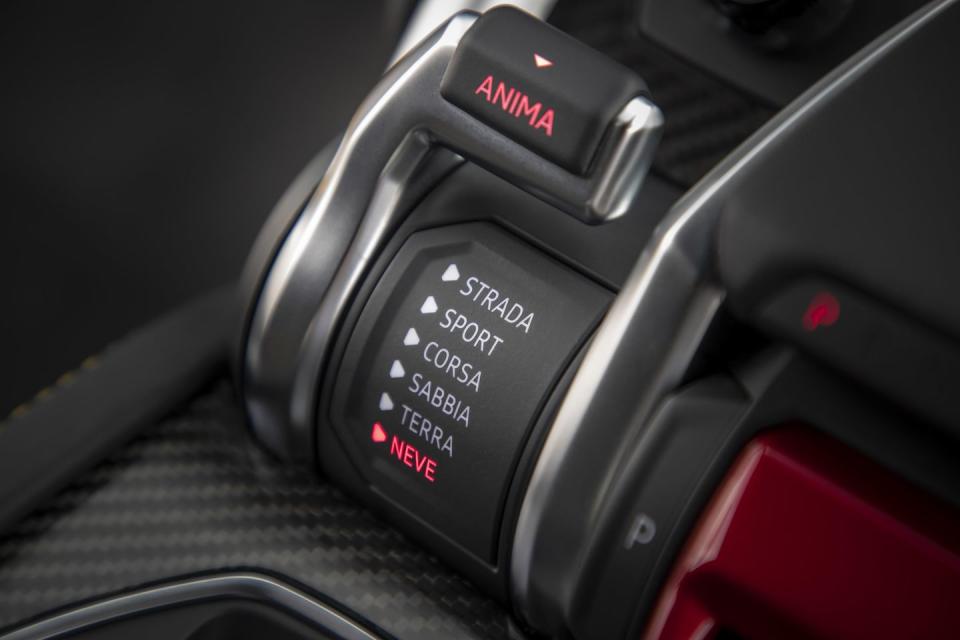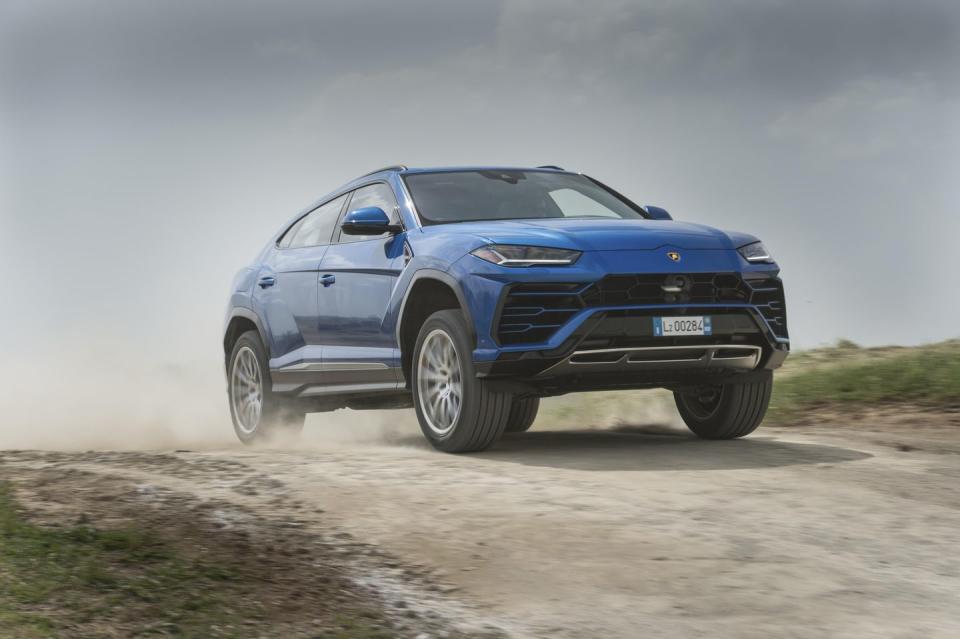The Lamborghini Urus Is a Driver-Friendly Supercar With an Endearing Lack of Logic

Base Price: $211,321 / Top Speed: 190 mph / Zero to 60: 3.2 second / Meaning of Name: The undomesticated extinct ancestor of the modern bull (most Lamborghini models names are bull-related) / Engine: Twin-turbo 4.0-liter V8 / Horsepower: 641 at 6,000 rpm / Passenger Capacity: 5 / Fuel Economy: 12 mpg (combined)
Every Lamborghini, including this one, has some magic. Its cars are still the stuff of phone wallpaper and hip-hop choruses. Inside and outside, they have parts that are just slightly more ridiculous than they need to be.
Sure, less so since VW Group acquired the company in the late 90’s, and less so in the Urus, which is built with lots of Audi parts. But the Urus still has on-brand excess. Almost everything you touch is focused on speed and making you conspicuous. Which is wonderful, and makes it special if you ever get the chance to drive one. But all that can make it intimidating to operate.
The steering wheel is probably different than you’re used to — the bottom third looks like it’s been hammered flat. Cars that prioritize speed do this for reasons that have never really been defined, but are easy to argue. One advantage: easier entry and exit, if you’re switching drivers mid-race. Another: more room for working the pedals when going straight. Also, along with the vertical strip at 12:00, the design helps you quickly orient how far you’ve turned the wheel.
Same as Mercedes-Benz AMG, BMW M, or Audis with S in the model name, the Urus has some design decisions where the explanation is simply, “It’s like that in race cars.”

The Start/Stop button for the electronics and engine is between the front seats, under a red cover, same as other modern Lamborghinis. The idea is, like missile launch systems, that button's power is so great that accidental activation could be dangerous. See? Pleasantly ridiculous. Flip it up, hold down the brake pedal, and press that button—you can do this without lifting the gate if you have thin fingers, but it’s more fun to do it the way Lamborghini wants you to. The twin-turbo V8 will fire up and announce you to the block.
Same as most expensive, modern cars, you can choose how much efficiency and comfort you want to trade for speed. You can also decide whether you want the car’s computer to tune itself for different driving conditions. In the Urus, those options are listed Italian, to the left of the Start/Stop button. To cycle through your options, pull on the top lever labeled ANIMA. It’s Italian for something like soul or spirit. It's also an acronym for Adaptive Network Intelligent MAnagement.

Strada - “Street” is as normal as the Urus gets. It shifts to high gears quickly and cuts off the engine at stop lights for better fuel efficiency.
Sport - Stiffer suspension, quicker acceleration. This also lowers the car slightly for better aerodynamic efficiency.
Corsa - “Race” is even stiffer and faster. Same as Sport, this setting will keep the engine revving high to make power immediately available, at the expense of smoothness and miles per gallon.
Sabbia - “Sand” will raise the suspension slightly, and the system will watch for wheel spin to keep you from sliding or getting stuck. Lamborghini sells lots of cars in desert regions like Dubai and Saudi Arabia.
Terra - “Land” or “Earth” is the closest this car gets to off-roading, though you probably don’t want to do this with the tires that came with your Urus. Same as Sabbia, this setting watches for wheel spin and prioritizes traction.
Neve - “Snow” is also conservative, and deploys power judiciously to keep traction on very slippery surfaces.
If you want to pick your own arrangement, the lever to the right of Stop/Start labeled EGO (“individual”) lets you pick which collection of steering (gentle versus responsive), throttle response (efficiency versus speed), and suspension (pothole absorption and body roll versus rigidity and road vibration).
Once you’ve picked the ideal setting for the weather and your mood, you can go into reverse by pulling back on the lever above the stop/start button. To go forward, you can click that lever to cycle into Drive, or, as in most supercars, pull the right paddle on the steering column to upshift into Drive, or first gear. Also the same as on most cars like this: even if the parking brake is engaged, tapping on the accelerator will unlock it and you will start moving.

Also the same as most modern, fast, expensive cars, you can actually ignore those paddles. In Strada, the Urus defaults to fully automatic. You can drive it like a Prius. If you want to open up the V8 and its 641 horsepower on a highway on-ramp, you can pull on the left paddle (downshift), and pick gears yourself. (Same as any modern performance car, the fun part is finding straight, traffic-free road, and pulling the left paddle until the tachometer is somewhere above 5,000 rpm.
Mash the gas pedal, and upshift around where the needle hits red. Upshift with the right paddle as needed, though in Strada and Sport modes, the car will do this automatically before you do any damage). Worth noting: The Urus has these enormous 17.3-inch carbon-ceramic brakes with 10-piston calipers. You can stop much more quickly than you think for such a big heavy car.
At slower speeds, you’ll notice small features that make it easy to park without damaging the expensive bodywork. There’s rear-wheel steering, where the back wheels turn the opposite direction of the front wheels like on a hook and ladder fire truck, so you can corner more sharply. Something else you'll see on modern, expensive cars: lots of cameras and sensors. Shift into reverse, and the center screen shows you the back-facing camera, and a top-down view. Beeps will warn you before you nick a curb, and the car will stop itself before you back into a wall.

The two-seat Lamborghinis, the Aventador and Huracán, have very low ground clearance, for aerodynamic efficiency. That means that when you drive one, you approach every driveway and speed bump slowly and at an angle to avoid scraping the expensive bottom lip on the road. There’s a contraption that will raise the front end of the car for this exact purpose — it’s a $3,500 option on the Huracán. When you use it, the front end goes from a little over 5 inches to just under 7 inches (175mm) of clearance. Once you accelerate past around-town speeds, it automatically lowers.
The Urus doesn’t have and doesn’t need this. In Strada mode, it will clear just under 10 inches, enough for most civilian driving most of us will do. Along with cargo and passenger capacity, clearance is among the conveniences the Urus has that other cars with those performance numbers do not.
If all that sounds like a lot to keep in mind, it's worth mentioning that it’s not much more complex than the user-interface overload you find in most modern cars — the Model 3 is the only exception. But that complexity is part of why the Urus works. Same as every other expensive car with multiple screens and dozens of buttons, this car is overloaded with options. But Lamborghini gets away with it.
This is what car geeks mean when they talk about the endearing lack of logic in Italian cars. Even in this, the most friendly Lamborghini ever, you can be a grown adult, and pretend like you’re a test pilot. You’re less likely to be frustrated and confused by the cruise control buttons when you use an aircraft thrust lever to shift into reverse.
You Might Also Like


